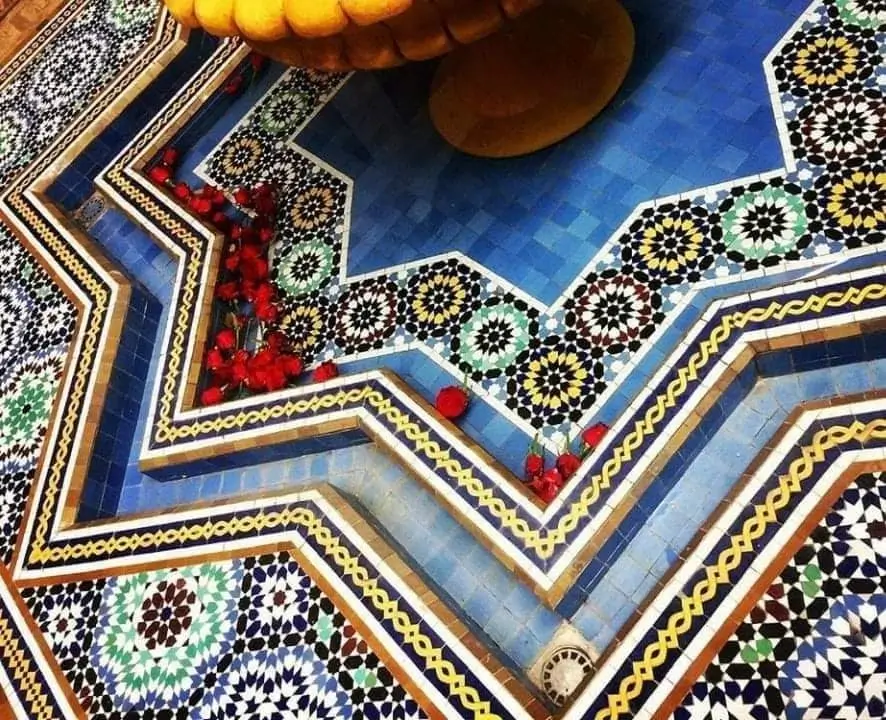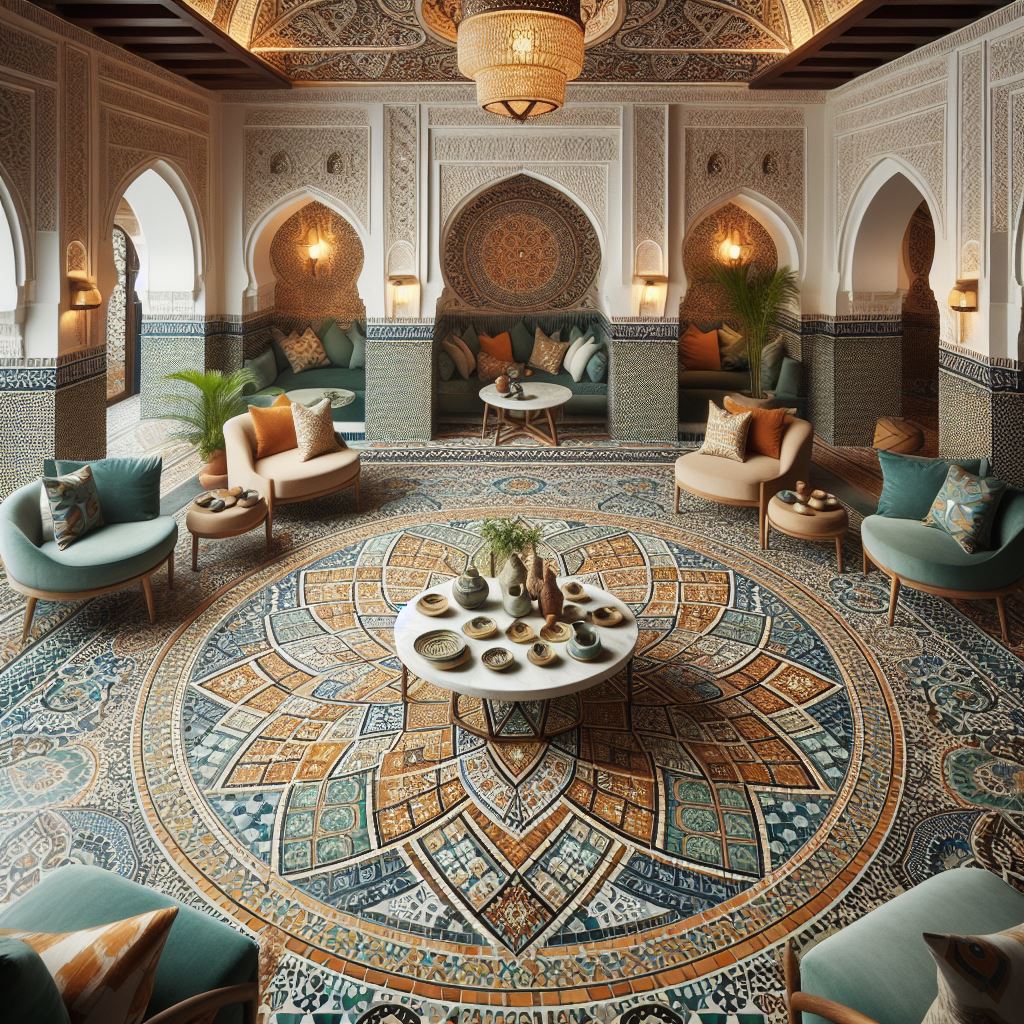Why Everyone Is Obsessed with Moroccan Ceramic Tiles – Find Out Now!
Moroccan Ceramic Tiles: A Timeless Elegance
Introduction
Welcome to the World of Moroccan Ceramic Tiles
Prepare to embark on a journey through the vibrant world of Moroccan ceramic tiles, where centuries-old traditions meet contemporary design sensibilities. These tiles, renowned for their intricate patterns and rich cultural heritage, have fascinated people around the globe for generations.
Table of Contents
Brief History of Moroccan Ceramic Tiles
The history of Moroccan ceramic tiles dates back to the 10th century when the art form was introduced by Moorish craftsmen. Over the centuries, Moroccan artisans perfected their techniques, blending influences from Berber, Arab, and Andalusian cultures to create unique tile designs that reflect the country’s diverse heritage.
Why Moroccan Ceramic Tiles are Popular Today
In recent years, Moroccan ceramic tiles have experienced a resurgence in popularity, thanks to their timeless appeal and versatility. Designers and homeowners alike are drawn to the tiles’ ability to add character and charm to any space, whether it’s a traditional riad in Marrakech or a modern apartment in New York City.
The Art of Moroccan Ceramic Tiles
Traditional Techniques and Processes
Moroccan ceramic tiles are typically handcrafted using time-honored techniques that have been passed down through generations. Artisans carefully shape each tile by hand, using molds and tools crafted from locally sourced materials.
Tools and Materials Used
From clay and water to intricate molds and carving tools, Moroccan tile artisans rely on a variety of materials and tools to bring their designs to life. Each element plays a crucial role in the tile-making process, ensuring that every finished product is a true work of art.
Intricate Designs and Patterns
Geometric Motifs
One of the defining features of Moroccan ceramic tiles is their intricate geometric patterns. Inspired by traditional Islamic art and architecture, these designs often feature symmetrical shapes and repeating motifs that create a sense of harmony and balance.
Floral Patterns
In addition to geometric motifs, Moroccan ceramic tiles also frequently incorporate floral patterns inspired by the country’s rich botanical heritage. From delicate roses to bold lilies, these designs add a touch of natural beauty to any space.
Islamic Calligraphy
Another hallmark of Moroccan ceramic tiles is the use of Islamic calligraphy, which often adorns religious buildings and architectural landmarks throughout the country. These intricate designs, featuring verses from the Quran and other sacred texts, serve as a reminder of Morocco’s deep spiritual and cultural traditions.
Symbolism and Cultural Significance
Influence of Islamic Art
Moroccan ceramic tiles are deeply rooted in Islamic art and culture, drawing inspiration from the intricate designs found in mosques, palaces, and madrasas across the Muslim world. These tiles serve not only as decorative elements but also as symbols of faith and spirituality.
Meaning Behind Common Symbols
Many of the patterns and symbols found in Moroccan ceramic tiles hold special significance in Moroccan culture. For example, the eight-pointed star, known as the “star of Ishtar,” symbolizes prosperity and good fortune, while the “eye of Fatima” is believed to protect against evil spirits and negative energy.
Types of Moroccan Ceramic Tiles
Zellige Tiles
Characteristics
Zellige tiles are small, colorful tiles known for their dazzling array of hues and intricate patterns. Each tile is hand-cut and hand-glazed, resulting in a unique piece of art that adds warmth and personality to any space.
Production Process
The production of zellige tiles is a labor-intensive process that begins with the hand-cutting of clay into small, uniform pieces. These pieces are then glazed and fired in a kiln, resulting in a finished tile that is both durable and beautiful.

Applications in Architecture and Design
Zellige tiles are commonly used in Moroccan architecture to adorn walls, floors, and ceilings. Their vibrant colors and geometric patterns make them a popular choice for everything from mosques and palaces to private homes and hotels.
Fes Tiles
Origins and Characteristics
Fes tiles, also known as “Fez tiles,” are named after the historic city of Fez, which has long been renowned for its ceramic arts. These tiles typically feature intricate floral and geometric designs, reflecting the city’s rich cultural heritage.
Design Variations
Fes tiles come in a variety of shapes and sizes, ranging from small, square tiles to larger, rectangular ones. Each tile is meticulously handcrafted by skilled artisans, ensuring that no two are exactly alike.
Usage in Traditional Moroccan Architecture
Fes tiles have been used in Moroccan architecture for centuries, adorning the walls, floors, and fountains of palaces, mosques, and private residences. Their timeless beauty and craftsmanship continue to captivate visitors from around the world.
Bejmat Tiles
Features and Characteristics
Bejmat tiles are thin, rectangular tiles known for their rustic appearance and irregular edges. Made from terracotta clay, these tiles have a natural, earthy charm that adds warmth and authenticity to any space.
Installation Techniques
Bejmat tiles are typically installed using a traditional technique known as “juxtaposition,” in which the tiles are laid closely together with minimal grout lines. This creates a seamless, cohesive look that enhances the tiles’ rustic appeal.
Modern Applications
In recent years, bejmat tiles have gained popularity in modern design circles for their versatile aesthetic and eco-friendly credentials. From kitchens and bathrooms to outdoor patios and pool decks, these tiles offer a timeless yet contemporary look that complements a wide range of architectural styles.
Colors and Glazes
Traditional Color Palette
Earthy Tones
Moroccan ceramic tiles are known for their earthy color palette, which includes shades of terracotta, ochre, and sand. These warm, natural hues evoke the rugged beauty of Morocco’s desert landscapes, creating a sense of warmth and serenity in any space.
Vibrant Hues
In addition to earthy tones, Moroccan ceramic tiles also come in a vibrant array of colors, including rich blues, greens, and yellows. These bold hues add a pop of color and personality to any room, creating a lively and inviting atmosphere.
Glazing Techniques
Glossy vs. Matte Finishes
Moroccan ceramic tiles can be finished with either a glossy or matte glaze, each of which offers its own unique aesthetic appeal. Glossy finishes reflect light and add depth to the tiles’ colors, while matte finishes have a more subdued, understated look.
Glaze Application Methods
The glazing process for Moroccan ceramic tiles is a highly skilled and labor-intensive endeavor, often requiring multiple layers of glaze to achieve the desired effect. Artisans use a variety of techniques, including dipping, spraying, and hand-painting, to create intricate patterns and designs.
Applications of Moroccan Ceramic Tiles
Interior Design
Moroccan-inspired Décor Ideas
Incorporating Moroccan ceramic tiles into your home décor is a great way to add a touch of exotic elegance to any space. Consider using zellige tiles to create a colorful backsplash in your kitchen or bathroom, or use bejmat tiles to add warmth and texture to your living room floor.
Incorporating Moroccan Tiles into Modern Spaces
Moroccan ceramic tiles are incredibly versatile and can be used in a variety of modern design schemes. Mix and match different tile styles and colors to create a custom look that reflects your personal style and tastes.
Exterior Design
Moroccan Courtyards and Gardens
Moroccan ceramic tiles are not just for indoor use – they can also be used to create stunning outdoor spaces. Use fes tiles to create a mosaic pathway in your garden or patio, or use bejmat tiles to create a colorful border
around your swimming pool.
Façade Embellishments
Add a touch of Moroccan flair to your home’s exterior by using ceramic tiles to embellish your façade. Create a striking focal point by using zellige tiles to cover an entire wall or column, or use bejmat tiles to create a decorative border around your windows and doors.
Commercial Spaces
Restaurants and Cafés
Moroccan ceramic tiles are a popular choice for restaurants and cafés looking to create a warm and inviting atmosphere for their customers. Use colorful zellige tiles to create a vibrant mosaic bar or use fes tiles to create a decorative feature wall in your dining area.

Hotels and Resorts
Create a luxurious retreat for your guests by incorporating Moroccan ceramic tiles into your hotel or resort design. Use bejmat tiles to create a serene spa environment or use zellige tiles to add a touch of exotic elegance to your guest rooms and suites.

Maintenance and Care Tips
Cleaning Techniques
Routine Maintenance
To keep your Moroccan ceramic tiles looking their best, it’s important to clean them regularly with a mild detergent and warm water. Avoid using harsh chemicals or abrasive cleaners, as these can damage the tiles’ glaze and cause them to lose their luster.
Dealing with Stubborn Stains
If you encounter stubborn stains on your Moroccan ceramic tiles, try using a mixture of baking soda and water to gently scrub the affected area. For more stubborn stains, consider using a commercial tile cleaner or a solution of vinegar and water.
Protecting Moroccan Ceramic Tiles
Sealants and Coatings
To protect your Moroccan ceramic tiles from damage and wear, consider applying a sealant or coating to the surface. This will help to prevent stains and moisture from penetrating the tiles, prolonging their lifespan and beauty.
Avoiding Damage
To avoid damaging your Moroccan ceramic tiles, be sure to use coasters and trivets under hot or heavy objects, and avoid dragging furniture or other items across the tiles’ surface. Additionally, be careful when cleaning the tiles to avoid scratching or chipping them.
Where to Find Moroccan Ceramic Tiles
Local Markets and Souks
If you’re lucky enough to be in Morocco, be sure to visit the local markets and souks, where you’ll find a wide selection of authentic Moroccan ceramic tiles. These markets are a treasure trove of colorful tiles, pottery, and other handmade crafts.
Online Retailers and Artisanal Websites
If you’re unable to travel to Morocco, don’t worry – there are plenty of online retailers and artisanal websites that offer a wide selection of Moroccan ceramic tiles. Look for websites that specialize in handmade and artisanal products, as these are more likely to offer authentic and high-quality tiles.
Specialty Tile Stores and Showrooms
Many specialty tile stores and showrooms carry a selection of Moroccan ceramic tiles, ranging from traditional designs to more modern interpretations. Visit your local tile store or showroom to see the tiles in person and get inspiration for your next design project.
Inspiration and Design Ideas
Moroccan Tile Patterns for Different Spaces
Whether you’re decorating a kitchen, bathroom, or outdoor patio, there’s a Moroccan tile pattern to suit every space. Consider using bold, geometric patterns in high-traffic areas like kitchens and bathrooms, and more subtle, floral patterns in quiet, intimate spaces like bedrooms and reading nooks.
Combining Moroccan Tiles with Other Materials
Get creative with your Moroccan tile design by combining different materials and textures. Pair zellige tiles with rustic wood accents for a warm and inviting look, or mix and match different tile styles and colors to create a one-of-a-kind mosaic masterpiece.
DIY Projects and Customization Ideas
Feeling crafty? Why not try your hand at a DIY Moroccan tile project? From creating a colorful mosaic tabletop to adding a decorative tile border to your bathroom mirror, the possibilities are endless when it comes to incorporating Moroccan tiles into your home décor.
Conclusion
The Timeless Elegance of Moroccan Ceramic Tiles
Incorporating Moroccan Tile Aesthetics into Your Space
Embracing the Beauty of Moroccan Craftsmanship
In conclusion, Moroccan ceramic tiles are more than just decorative elements – they’re a testament to centuries of craftsmanship and tradition. Whether you’re renovating your home or simply looking to add a touch of exotic elegance to your space, Moroccan tiles are sure to make a lasting impression. So why wait? Explore the world of Moroccan ceramic tiles today and bring a piece of Morocco’s rich cultural heritage into your own home.

